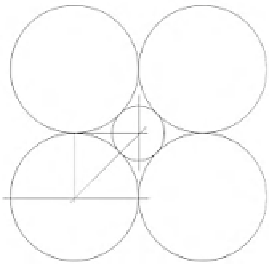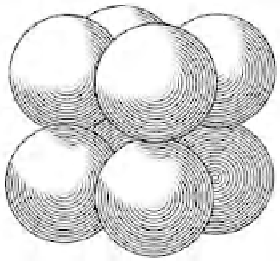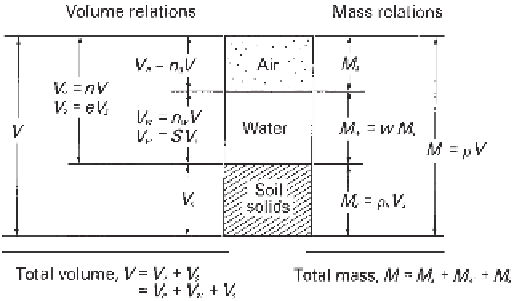Environmental Engineering Reference
In-Depth Information
Equation 2.48 provides an approximation of the relation-
ship between the air-entry value of a soil and the radius
of the largest soil particles in a soil. Equation 2.48 can be
abbreviated as a ratio of the soil particle size if the surface
tension of water is taken to be 0.07275 N/m:
0
.
3513
R
u
a
−
u
w
=
(2.49)
The radius of the particles is in millimeters and matric
suction is in kilopascals for a constant of proportionality of
0.3513. The above simplified analysis involving uniform
spheres forms the basis of Fig. 2.41. The diameter of
the particles and the pore sizes are shown on the hori-
zontal axis.
(a)
2.4 VOLUME-MASS VARIABLES
There are a series of volume relations, mass relations,
and volume-mass relations that form useful properties in
geotechnical engineering practice. The volume relations are
presented first, followed by the mass relations and then the
volume-mass relations.
R
45
°
(b)
2.4.1 Porosity
Porosity
n
in percent is defined as the ratio of the volume
of voids,
V
v
, to the total volume
V
(Fig. 2.45):
Figure 2.44
Arrangement of particles used to calculate open
space between particles. (a) Cubic packing arrangement (after Gra-
ton and Fraser, 1935). (b) Geometry of a simple cubic layer.
V
v
(
100
)
V
n
=
(2.50)
Let us simply consider the case where a series of spheres
are the same size. The largest pore in a closely packed sys-
tem of uniform spheres occurs with a cubic arrangement of
spheres, as shown in Fig. 2.44. Figure 2.44b shows the geom-
etry of a simple cubic layer. The capillary theory can be used
to calculate the matric suction corresponding to the air-entry
value. A right-angled triangle can be formed by drawing a
line from the contact point of two of the spheres to the cen-
ter of the inner capillary circle, as shown in Fig. 2.44b. A
geometric relationship is formed between the radius of the
capillary circle,
r,
and the radius of the spherical particle,
R:
The term porosity can also be applied as the volumetric
portion of each phase referenced to the total volume. There-
fore, water and air porosities can be defined as follows:
V
w
(
100
)
V
n
w
=
(2.51)
V
a
(
100
)
V
n
a
=
(2.52)
R
cos 45
−
r
=
R
(2.47)
where:
r
=
radius of the pore opening, and
R
=
radius of the spherical particles.
The pressure difference across a three-dimensional surface
can be described using the capillary equation (i.e., Eq. 2.46),
assuming the contact angle,
α
1
, is zero. The matric suction at
the air-entry point can be calculated by substituting Eq. 2.47
into the capillary equation:
2
T
s
R/(
cos 45
)
Figure 2.45
Relationship between volume and mass of unsatu-
u
a
−
u
w
=
(2.48)
−
R
rated soil.














Search WWH ::

Custom Search